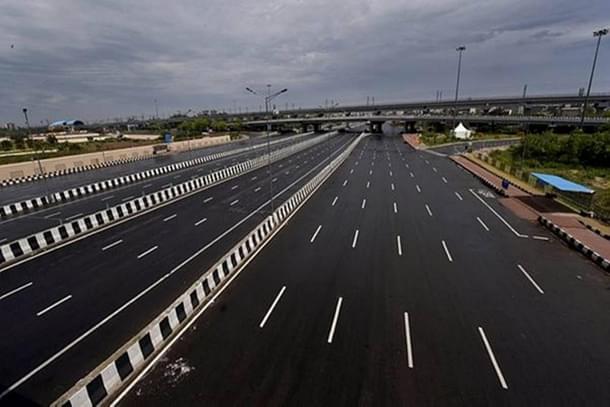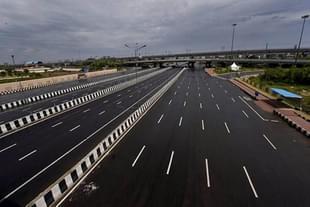Infrastructure
2022: The Year That Saw A Major Push In Highway Development
Arun Kumar Das
Jan 06, 2023, 11:58 AM | Updated 11:37 AM IST
Save & read from anywhere!
Bookmark stories for easy access on any device or the Swarajya app.


In a major highway development push, Prime Minister Narendra Modi initiated projects worth more than Rs 57,020 crore in 2022.
While 5,337 km of National Highways (NHs) were constructed in 2022, contracts were awarded for construction of 6,318 km of NHs last year.
While 27 greenfield expressways are being developed across the country, the year 2022 also witnessed a thrust on ropeway projects under Parvatmala with a big push to logistics development in the country in line with National Logistics Policy.
India has about 63.73 lakh km of road network, which is the second largest in the world. The length of various categories of roads includes 144,634 km of NHs, 186,908 km of state highways and 5,902,539 km of other roads.
NHs play a very important role in the economic and social development of the country by enabling efficient movement of freight and passengers and improving access to markets.
The Ministry of Road Transport and Highways increased the pace of NH construction with the systematic push through corridor-based NH development approach.
In 2014-15, the pace of NH construction was about 12 km per day which increased to about 29 km per day in 2021-22.
Road transport is the dominant mode of transport in India, both in terms of traffic share and contribution to the national economy. Apart from facilitating the movement of goods and passengers, road transport plays a key role in promoting equitable socio-economic development across regions of the country.
It also plays a vital role in social and economic integration and development of the country. Easy accessibility, flexibility of operations, door-to-door service and reliability have earned road transport a greater significance in both passenger and freight traffic vis-a-vis other modes of transport.
Strengthening the intelligent transport system (ITS) in the public transport system, the ministry has revamped its previous ITS scheme and issued guidelines to this effect improving customer conveniences.
Ropeways have emerged as a convenient, safe and preferred mode of transportation to provide both, first as well as last mile connectivity to such hilly and inaccessible areas or to help decongest urban congestion areas. In this backdrop, the Centre is giving a major push to ropeway development in the country.
The Ministry of Road Transport and Highways, responsible for the development of highways and regulating the road transport sector across the country, has undertaken the development of ropeways and alternate mobility solutions in the country under Parvatmala plan.
The Prime Minister had laid the foundation stone of two new ropeway projects connecting Gaurikund to Kedarnath and Govindghat to Hemkund Sahib in Uttarakhand. The ropeway in Kedarnath will be around 9.7 Km in length and will connect Gaurikund to Kedarnath, thereby reducing the travel time between the two places from 6-7 hours at present to merely 30 mins.
The Hemkund ropeway will connect Govindghat to Hemkund Sahib. It will be around 12.4 km in length and will reduce the travel time from more than a day to only about 45 mins. This ropeway will also connect Ghangaria, which is the gateway to Valley of Flowers National Park.
An MoU was signed between Madhya Pradesh government and NHAI for construction of ropeways at 14 selected places in the state.
For safety and security of women passengers the government of India has set up a dedicated fund under the Nirbhaya Framework.
Safety measures for children below four years of age riding or being carried on a motor cycle: The ministry also amended the rule for strengthening safety measures for children below four years of age, riding or being carried on a motor cycle.
Compensation to victims of hit and run motor accidents increased from Rs 12,500 to Rs 50,000 for serious accident and Rs 25,000 to Rs 2 lakh for death.
The year 2022 saw a big push to green fuel and vehicles and also a series of steps undertaken to improve safety of electric vehicles.
NHAI has created a Guinness World Record for the longest continuously laid bituminous lane of 75 km in 105 hours and 33 minutes on the national highway between Amravati and Akola districts in Maharashtra.
The project was implemented by 720 workers including a team of independent consultants who worked day and night. The total length of the 75 km of single-lane continuous bituminous concrete road is equivalent to 37.5 km of two-lane paved shoulder road and the work started on 3 June, at 7:27 am and was completed on 7 June, at 5pm.
The previous Guinness World Record for the longest continuously laid bituminous was for building 25.275 km of road which was achieved in Doha, Qatar in February 2019 and that task was completed in 10 days.
Arun Kumar Das is a senior journalist covering railways. He can be contacted at akdas2005@gmail.com.





